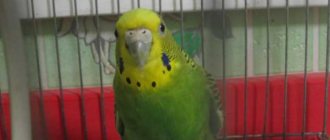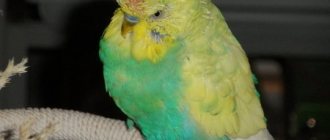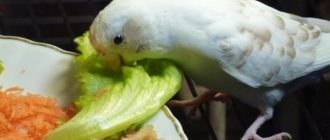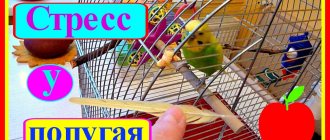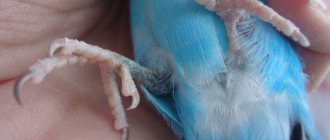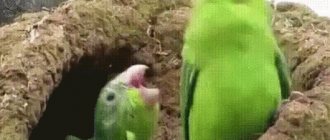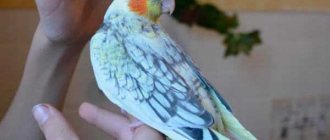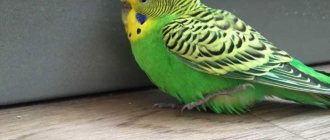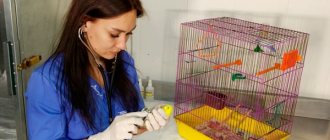Boiling activity, cheerful chirping and constant mischief - it's all about the budgie. We are used to thinking of wigglers as real living beings. And if it suddenly turns out that the parrot is sitting at the bottom of the cage, ruffling its feathers and closing its eyes, then this is a cause for concern. Why doesn't he fly or sit on a perch? This can be explained by observing the bird for a longer period of time. Let's look at a few possibilities.
Poisoning
The decrease in activity is associated with poisoning - the parrot could have swallowed something dangerous or inhaled toxic fumes. Parrots are curious, they bite and taste their surroundings. You should not leave your pet unattended while walking, otherwise he will definitely get into trouble. Poisoned parrots quickly lose strength, fall to the bottom of the cage and sit with their eyes closed, ruffling their feathers, not reacting to external stimuli.
Poisoning in a parrot
Household poisoning risks include:
- Worries. A parrot may confuse brightly colored capsules or tablets lying on the table with a treat.
- Houseplants. Among them there are specimens that are poisonous not only to birds, but also to humans. For example, ivy, dieffenbachia, azalea. Some of them poison the air, others are dangerous if swallowed, and parrots just love to nibble on grass.
- Liquids. The pen can be drunk from open glasses or containers: alcoholic beverages, vinegar, coffee, various marinades.
- Aerosols. In high concentrations, perfumes and air fresheners are harmful to parrots. You can also add smoke from heated Teflon cookware to this list.
- Newspapers magazines. Parrots love to tear paper into pieces and even swallow it. Blank paper is completely harmless, but the same cannot be said about newspapers - the chemicals in printing ink are very toxic.
- Prohibited foods for feeding parrots. Often, owners themselves poison their pets when they offer them food from their plate.
Please note! A parrot can become poisoned by chewing a low-quality toy. Pieces of plastic, once in the stomach, begin to release toxins into the body.
At best, the bird suffers from a mild intestinal disorder and recovers quickly. Severe poisoning deprives the bird of strength and will to live. It is accompanied by striking symptoms such as diarrhea, vomiting and cramps. An exhausted parrot lies at the bottom of the cage and trembles. If the unit does not receive help in time, it will die.
What causes trembling
There are many reasons why a cockatiel or budgie trembles:
1.The pet is cold. When getting a parrot, you need to remember that it is very sensitive to temperature fluctuations and drafts. The minimum temperature in the room in which the pet lives should be 18 degrees. When ventilating during the cold season, the cage with the budgie should be moved to the next room where the windows are closed. To warm the bird near the cage at a distance of 0.5 meters, you need to place a lamp and point it at the bottom of the cage. On one side, the cage should be curtained with fabric to create shade and the pet can choose a place with a comfortable temperature. It is important not to overheat the bird, in which case it will experience dyspnea, breathing with an open beak, and outstretched wings.
2. Stress . Often the parrot begins to shake with fear. There can be a variety of reasons why a pet is scared. This could be moving to a new place of residence. Usually within 3 days the budgie gets used to its new place of residence. During this period, you should leave your pet alone; you should not let him out of the cage, stand in front of him for a long time, talk loudly or train him. All this time, you should talk to the bird gently and quietly, and give it treats. If after this time the bird has not adapted, then the reason is most likely not due to stress. Although it takes up to 10 days for the cockatiel to get used to the new environment. At the same time, the bird may behave aggressively: it may attack objects in the cage; it may not like the perch, feeder, or anything else. In this case, it should be removed so as not to irritate the pet.
3. Loud sounds can frighten your pet , so you should not talk loudly or play loud music in the room where he is kept. Other pets or children can scare the bird. If the parrot's wings are trembling, then it is worth finding out whether anyone approached the cage or whether children were making noise near it. It is important to explain to all family members that the parrot is a living creature and must be treated with care.
4. Vitamin deficiency . If a bird's diet is monotonous, it will begin to lack vitamins. The development of vitamin deficiency may be indicated by the fact that the parrot’s wings are shaking, the feathers are ruffled, the pet has no appetite and is indifferent to what is happening. In this case, you need to diversify the bird's diet. He needs to be given various grain mixtures, herbs, fresh vegetables and fruits. After consultation with a specialist, you can give your pet a vitamin and mineral complex. You should not do this yourself, since multivitamins also have contraindications and only a veterinarian can choose the drug and dosage that is suitable for a particular parrot.
Another reason why the parrot is ruffled and trembling may be illness.
If your budgerigar or cockatiel exhibits the following symptoms, it should be shown to a doctor as soon as possible:
- for some unknown reason the bird refuses to eat;
- the pet has stool problems (constipation or diarrhea), vomiting, purulent nasal discharge, lack of coordination, respiratory distress, convulsions;
- he is lethargic, indifferent to everything, sits ruffled in one place with his eyes closed;
- the bird is constantly itching, its feathers fall out or it plucks them itself; this behavior can be observed if the pet has a fungus or mite;
- the bird began to make new sounds, its voice changed;
- she has a broken wing or other injuries.
If, in addition to trembling, the symptoms listed above are observed, the pet should be shown to a specialist as soon as possible.
Why do this? Only a doctor can make the correct diagnosis, because the listed signs may indicate that the parrot has:
- pathologies of internal organs;
- viral and fungal infection;
- helminthic infestation;
- allergy;
- poisoning, etc.
You should not try to make a diagnosis yourself and give the bird medicine on the advice of friends and acquaintances, as the disease may progress and the parrot will die.
Colds
Strange as it may sound, domestic parrots, although kept in “greenhouse” conditions, catch colds more often than free birds. At home, fragile animals react more strongly to changes in temperature and humidity and are very afraid of drafts. An open window in the hot summer is one of the most common causes of colds.
Many parrots love to swim and take advantage of this opportunity quite often. However, after water treatments, the bird does not always have time to dry, especially in a cool room, so it catches a cold.
- sneezing;
- runny nose;
- cough;
- chills.
Sneezing is accompanied by discharge from the nostrils, the parrot also experiences itching in the respiratory tract and often scratches the earwax with its claws. Body temperature rises, tremors appear, the bird tries to warm up and hides its beak in its feathers. The general condition of the bird worsens, which affects its activity: it will not fly and jump, but will sit in the corner of the cage, huddling into a ball and saving energy.
How to prevent your feathered pet's condition from getting worse
For a long and healthy life of a parrot, it is important to comply with all the conditions of its maintenance. It is important to carefully monitor his behavior and the slightest deviations from the norm. If a parrot raises its feathers, puffs itself up, has its eyes closed, and hides its head under its wing, this is hypothermia.
Temperature is an important factor for the health of a pet parrot. Variegated birds naturally live in hot countries. Warmth is their natural habitat. But they also do not tolerate heat well. The optimal comfortable temperature should range from +22…+25 C°. It is allowed to drop to +18 Cᵒ, but no more than an hour. This temperature is not comfortable for heat-loving birds and can cause the development of colds.
Higher temperatures and dry air provoke the appearance of skin diseases. This may be itching, loss of feathers, dry mucous membranes. As a result, the parrot begins to lose appetite and may get sick.
Chills and ruffled feathers are not symptoms of serious illness. Heating and a calm environment in the house will quickly relieve your pet from discomfort. If all the conditions are met, and the bird only gets worse, it is important not to ignore other symptoms. If the disease is detected at an early stage, it responds well to treatment.
Desire to breed
Owners of ornamental birds sometimes observe strange behavior in their pets: the parrot sits for a long time on the floor of the cage in the corner, then shakes itself and flies up onto a perch. It is impossible to tell from his appearance that there is cause for concern. Such actions indicate that the parrot is preparing for procreation.
Pregnant parrot
If there is a pair of mongrels living in a cage, this may be a sign that breeding has begun. It is worth supporting your pets' instincts by wearing a flap for them. However, if the only inhabitant of the household is a female parrot, then it is imperative to suppress her desire to reproduce. The mirror, twigs and paper should be removed from the cage. There should be no materials inside that can be used to build a nest. False incubations should be stopped, otherwise the parrot will lose its health in vain.
First aid
The reason for the hunching, combined with trembling, may be adaptation to new conditions. A parrot becomes anxious if it has been transported from one room to another or transferred to a new cage. Perhaps he requires more attention. You need to talk to him. If a bird attacks a new toy or an object it does not understand, they are removed from the cage. If the next morning the parrot behaves adequately, this means that adaptation has been successful. If the apartment is cold, cover the cage with a towel, leaving a gap and pointing an incandescent lamp at it or the tray.
You can independently correct the situation when a bird develops hypovitaminosis or is poisoned by a delicacy not intended for perroque. The situation can be corrected by introducing a sorbent. Enterosgel is best suited. It is squeezed out of the tube, diluted with water, and 3-4 drops are added using a syringe without a needle. Activated carbon is given in a similar way. You should catch the bird in semi-darkness, covering the cage with a towel to reduce frightening. When trembling and ruffling are associated with injury, the parrot must be urgently taken to the clinic.
Enterosgel
Improper feeding
The budgerigar is an active bird that is constantly on the move. A healthy parrot jumps from branch to branch, walks along the bottom and pecks grains, tears paper, but will not sit on the floor of the cage. So it’s not entirely clear why the parrot suddenly spends a lot of time downstairs. Probably his paws get tired of sticking to the perch and it’s more convenient for him to sit on the tray. The reason for this condition is poor nutrition: too much fatty food or lack of nutrients.
Obesity in a parrot
You should feed your pet not on demand, but on time, observing portion sizes. If you do not follow a diet, your parrot will become accustomed to overeating due to excess weight. A heavy body puts stress on the legs and wings. An obese bird has difficulty moving and is simply uncomfortable.
Monotonous food
A word of warning! It should also be noted that fasting is one of the causes of weakness in birds. The food may be of poor quality, and the parrot may not get enough of it. In some cases, malnutrition may be caused by switching to another food that the bird does not like.
Dangerous symptoms that may accompany a parrot with chills
The parrot's trembling, lethargy and closed eyes may indicate not only its hypothermia. If the cause is illness, then other symptoms will appear within 3 days. It is important to identify them as early as possible.
Clear signs of dangerous diseases:
- a bent leg tucked under the body or a drooping wing indicates dislocations and fractures;
- small purulent or bleeding wounds on the body - may indicate various skin diseases;
- digestive disorders: diarrhea, constipation, vomiting;
- lack of appetite, sleepiness, immobility indicate colds or poisoning;
- baldness with itching and redness of the skin indicates the presence of parasites in the bird;
- trembling with convulsions, loss of appetite, hoarseness, uncharacteristic sounds that the pet makes - this is a cold or goiter.
On a note! If the parrot is crested and trembling, or other dangerous symptoms appear, it is necessary to conduct an examination at a veterinary clinic.
Illness or injury
If your parrot is sitting or lying on its stomach at the bottom of the cage and is breathing heavily, this is an alarm. Most likely, this behavior indicates illness. Avian diseases are more common in parrots kept in pairs or flocks. Lonely pets also suffer from infectious diseases, parasites, joint diseases and metabolic disorders.
The bird cannot sit in the cage; it lies on its stomach if one or both legs are injured. These may be plantar ulcers, gout, arthritis or other abnormalities. The budgerigar has very delicate limbs and can easily be injured by dislocating, breaking or breaking a claw. Young birds often bump into mirrors, glass and furniture while free-ranging, which can cause concussions and cracks in internal organs. If your parrot is ruffling its feathers and is blindfolded but conscious, it should be examined. If you notice any abnormal positioning of the limbs or beak, contact your veterinarian.
Below is a list of ways to cope with the painful condition on your own.
Infection with worms
The destroyed intestinal mucosa in parrots infected with worms leads to various diseases. The bird’s body is depleted, weakened, and lacks microelements important for life. The products of helminth processing (their feces) accumulate in the parrot's body, which leads to severe intoxication. The feathered pet becomes lethargic, apathetic and drowsy. He loses his appetite, the wavy sharply loses weight, and when moving, the parrot loses its balance.
Treatment
Every owner should be able to provide first aid to their pet. In case of a cold, it is enough to warm the parrot (turn on the infrared lamp near the cage) and soak it in chamomile infusion.
Poisoning is a particular problem: small parrots metabolize very quickly. Once in the body, toxins immediately penetrate all systems. A fluffy parrot with its eyes closed unknowingly indicates that it needs immediate treatment. Sometimes it takes hours to count.
The procedure for eliminating intoxication is as follows:
- Dilute the sorbent (enterosgel, activated carbon, polysorb) with water and inject it into the beak in small portions. You can use a needleless syringe or dropper.
- Boil the rice in water until fully cooked, grind into a liquid porridge and let cool to room temperature. Place the food in the syringe and gently feed your parrot. One meal requires 1.5 ml of porridge.
- Poisoning is accompanied by vomiting and diarrhea. Keep feathers clean and clean the cage often.
A parrot flutters around under different circumstances, and this is not always a cause for concern. However, if the bird sticks to the corner of the cage and lies on its belly, it should not be left unattended. There are several reasons for this behavior: poisoning, illness or injury. When the first symptoms disappear and the parrot feels relieved, take him to the veterinarian.
Causes
Parrots tremble in the following cases:
- The bird froze. The cage stood on the window; it was opened slightly for ventilation and they forgot to close it.
- Stress. A change of environment, a newcomer, childish pampering, a cat who happens to be nearby are causes of fear. The parrot begins to fluff and can really get sick.
- Pathology. If no additional symptoms are observed, the perroque eats natural food, but is ruffled and trembling, hypovitaminosis can be suspected.
- Additional symptoms indicate the disease:
- sneezing;
- closing the eyes;
- vomit;
- liquefaction of litter.
The detection of at least one of the additional signs is grounds for contacting a veterinarian ornithologist. If no auxiliary symptoms are noted, the perroque owner can try to help the pet on their own.
Prevention
A tamed bird should be given more attention. The parrot must be kept in a standard cage, avoiding drafts, hypothermia and overheating. In winter, you cannot open the window on which there is a cage with a bird. In sunny weather, you need to keep a towel ready to protect the perroque from the burning rays.
You should not feed your parrot just anything. Professionals have developed special food for different breeds of birds. It is balanced in vitamins and other nutrients. It is necessary to protect your pet from excessive noise and contact with predators. When moving or moving, it is useful to give the anti-stress multivitamin drug “Radostin” - 3 days before and 3 days after the trip.
Radostin
Man is responsible for those he tames. If he is attentive to his pets, they will get sick less.
localvet.ru

